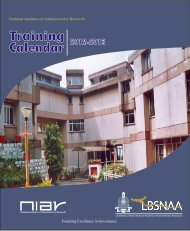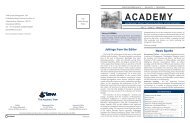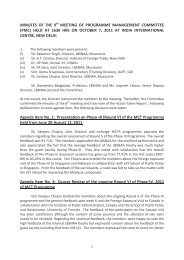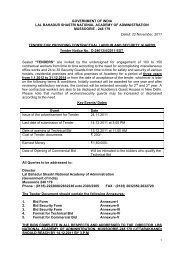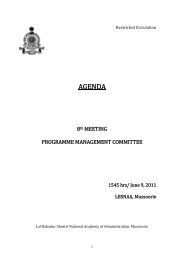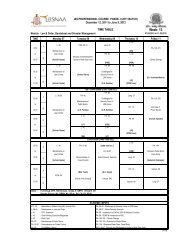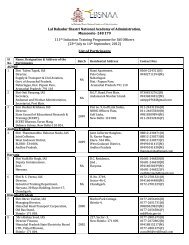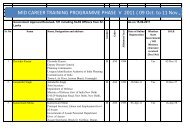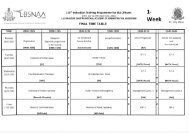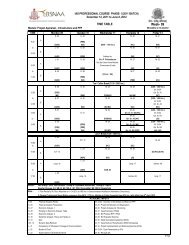Free Download - lbsnaa
Free Download - lbsnaa
Free Download - lbsnaa
Create successful ePaper yourself
Turn your PDF publications into a flip-book with our unique Google optimized e-Paper software.
GOOD GOVERNANCE | QUALITY | TRAINING<br />
Total Quality Management Cell<br />
Lal Bahadur Shastri National Academy of<br />
Administration, Mussoorie - 248 179<br />
Uttarakhand (INDIA)<br />
Tel. : +91 135 2632236, 2632489, 2632405<br />
tqmcell@<strong>lbsnaa</strong>.ernet.in<br />
Please send address changes to the above.<br />
Editor<br />
Dr. Moana Bhagabati<br />
moana_bh@<strong>lbsnaa</strong>.ernet.in<br />
The ACADEMY<br />
Editor<br />
Nidhi Sharma<br />
nidhisharma@<strong>lbsnaa</strong>.ernet.in<br />
The Academy Team<br />
Managing Editor<br />
Dr. S.H. Khan<br />
shkhan@<strong>lbsnaa</strong>.ernet.in<br />
We welcome articles and write-ups from our readers and subscribers. These can be sent to the Editor.<br />
Disclaimer : Views expressed by individual contributors do not necessarily represent the views or position of 'The Academy' and LBSNAA<br />
Affix<br />
Indian Postage<br />
Stamp<br />
Associate Editor<br />
Dr. M. Kennedy Singh<br />
kennedysingh@<strong>lbsnaa</strong>.ernet.in<br />
JANUARY-FEBRUARY 2011<br />
Vision of LBSNAA<br />
We seek to promote good governance by providing quality<br />
training towards building a professional and responsive<br />
civil service in a caring, ethical and transparent<br />
framework.<br />
Jottings from the Editor<br />
The months of January and February, the coldest in<br />
Mussoorie, yet crisp and dazzling bright, are also the months<br />
when the Academy gears itself up for an activity-packed<br />
year. It being the 'lean season', we bring you a joint issue<br />
covering events of both the months. With relatively lesser<br />
number of courses running than in other months, the faculty<br />
took turns to visit and supervise the field training of IAS<br />
officer trainees in their district postings. For those present on<br />
campus, couple of spells of snow around the middle and<br />
later half of February provided much excitement - to those<br />
who had never before witnessed snow 'au naturel', as well as<br />
to 'veterans' - snow never ceases to delight! This year,<br />
however, the usually languid month of January saw a fair<br />
share of spirited activity. Phase V of the Mid Career Training<br />
Programme (MCTP), hosting senior officers of the IAS,<br />
continued until the middle of the month. The Course was<br />
packed with intense classroom deliberations, workshop on<br />
issues and challenges in governance, and far-reaching<br />
strategy papers were written by the participants, all of<br />
whom hold key positions in government. January 14<br />
marked the culmination of this Course, in the duration of<br />
which the participants not only made meaningful<br />
contributions through their distinguished collective<br />
experiences, but also enthusiastically participated in many<br />
an extra-curricular activity, be it outdoor adventure, or the<br />
artistic venture.<br />
The 62nd Republic Day was celebrated with fervour by<br />
the Academy parivaar, with children of staff members<br />
turning out in their finest, making it the customary lively<br />
tradition in which LBSNAA celebrates the pluralistic values<br />
of the nation. A significant initiative being undertaken by the<br />
ACADEMY<br />
The<br />
Lal Bahadur Shastri National Academy of Administration<br />
Vol. 4 Issue 1 January-February 2011<br />
Academy is the adoption of E-office application wherein<br />
personalized services are enabled and employees receive<br />
electronic notification of services and transactions based on<br />
their need and requirements. Designed and developed by<br />
the National Informatics Centre, New Delhi, a capacitybuilding<br />
programme for E-office was conducted over the<br />
two months for the Academy workforce. February saw two<br />
important training workshops, in 'Public Private<br />
Partnership (PPP) in Urban Sector'; and the first National<br />
Training of Trainers (ToT) on 'ICT Essentials for<br />
Government Leaders', the latter in partnership with<br />
Department of Information Technology (DIT), GoI, and<br />
United Nations Asian and Pacific Training Centre for<br />
Information and Communication Technology for<br />
Development (UN-APCICT/ESCAP). The Secretary, DoPT,<br />
came a visiting in January along with other department<br />
officials, and toured the Academy premises.<br />
Meantime, the third week of February once again saw<br />
the Academy abuzz with youthful energy as it welcomed<br />
back the IAS officer trainees (Batch of 2010) to resume their<br />
Phase I of training. After two months of traversing the length<br />
and breadth of the country during Bharat Darshan, getting a<br />
feel of the quintessential India, it was a homecoming of sorts,<br />
as the young officer trainees prepare to spend the next four<br />
months until June 2011, learning the ropes of administration.<br />
In this issue, we pay homage to the late Yashwant Sonawane,<br />
who laid down his life for justice. In the same breadth we<br />
also salute the young crop of officer trainees who have taken<br />
up myriad challenges of governance by entering into the<br />
administrative services - we bring you an article on this.<br />
IN THIS ISSUE<br />
News Sparks............................................................... 2<br />
Faculty News ............................................................. 6<br />
Research Centres in Action ...................................... 7<br />
Many chuck cushy MNC<br />
careers for government jobs..................................... 8<br />
eSa vkSj esjh fgUnh ........................................................... 9<br />
fgUnh dk ân; dkQh fo'kky gS ..................................... 11
2<br />
3<br />
News Sparks<br />
News Sparks<br />
continued from page 2<br />
Cricket camaraderie: A wintry Mussoorie day saw its<br />
share of excitement with a friendly cricket match organized<br />
between the junior Sri Lankan Cricket Team and<br />
officers/staff members of LBSNAA on 13 January. The<br />
match was won by the guest Sri Lankan Cricket team.<br />
Phase V: The final weeks of Phase V in January were<br />
marked by rigorous workshops and discussions, apart from<br />
the customary Academy out-of-class activities. Some<br />
highlights of the programme:<br />
Workshop on Key Governance Issues and<br />
Challenges: A workshop on the theme was organized<br />
by the participants. Divided into four groups, their task<br />
was to identify the governance challenges that the<br />
country is facing. The groups worked overnight on<br />
January 12-13 and came out with suggestions to help<br />
mitigate the challenges. It was noted that governance<br />
implies a process of inter-relationships between<br />
multiple stakeholders, mediated through institutional<br />
mechanisms, directed towards a set of public services or<br />
goods; entitlements/opportunities.<br />
Key Governance Issues and related challenges were<br />
broadly categorized into:<br />
<br />
<br />
<br />
Institutional Framework<br />
Public Service Delivery<br />
Corruption<br />
These are not segregated from each other and their<br />
inter-locking constitutes a triadic relationship in the<br />
governance reform agenda.<br />
It was felt that the existing governance eco-system is<br />
characterized by<br />
<br />
<br />
<br />
<br />
Widespread corruption<br />
Poor accountability and transparency<br />
Leadership deficit<br />
Selective application of law<br />
Inadequate rational decision resulting in short term<br />
view and adhocism<br />
The working groups came out with the recommendation<br />
that the approach to identifying priority action points<br />
contributing towards a possible governance reform agenda<br />
includes issues that are<br />
Systemic<br />
<br />
<br />
Process related<br />
Symptomatic<br />
The key governance issues were analyzed and explored<br />
in depth for arriving at a strategic framework of action<br />
further divided into short term, medium term and long term<br />
perspectives. It was recommended that herein the key entry<br />
point triggers needed to be identified and activated.<br />
The above findings were validated at the plenary session.<br />
Amita Sharma, Rajiv Gauba, Pravesh Kumar, Jai Prakash<br />
and Gurucharan were charged with the responsibility, by<br />
their fellow participants, of working on the broad contours<br />
churned out as a result of the workshop. These are to be<br />
developed into a detailed paper to be forwarded to the Prime<br />
Minister Office, Department of Administrative Reforms &<br />
Public Grievances and the Cabinet Secretariat.<br />
Strategy Papers: As part of the programme<br />
curriculum, the participants of Phase V were to write<br />
strategy papers for various departments of Government<br />
of India. Prajapati Trivedi, Secretary, (Performance<br />
Management), Cabinet Secretariat led an expert team<br />
which evaluated the strategy papers. LBSNAA proposes<br />
to bring out a publication containing the twelve best<br />
strategy papers listed here:<br />
<br />
<br />
<br />
<br />
<br />
<br />
<br />
<br />
<br />
Food and Public Distribution: Jagan Nath Chamber<br />
and K.Anand<br />
Panchayati Raj: D.S.Misra and R.N.Srivastava<br />
Health and Family Welfare I: Anuradha Gupta and<br />
Leena Nair<br />
Health and Family Welfare II: Pradeep Shukla and<br />
V.S.Madan<br />
Power I: K.Ghanadesikan and Himanshu Das<br />
Power II: Sanjay Mitra and Deepak Sanan<br />
Commerce: D.S.Dhesi and Jayant Das Gupta<br />
Tourism: Vinod Zutshi and J.P.Prakash<br />
Telecommunication: Deepak Jagdish Saksena and<br />
Pravir Kumar<br />
Information Technology: Aruna Sundarrajan and B.<br />
Vijayan<br />
<br />
<br />
Overseas Indian Affairs: Gurcharan Gollerkeri and<br />
Khurshid A Ganai<br />
Urban Development: K.K.Sharma and D.Lakshmi<br />
Parthasarthy<br />
Valediction: The five week long Phase V of the Mid<br />
Career Training Programme came to a conclusion with<br />
the Valedictory Ceremony organized on 14 January 2011.<br />
continued on page 3<br />
watching and cultural events. The participation in these<br />
events was overwhelming, considering the rigorous<br />
academic inputs that were required of the participants in the<br />
nature of a strategy paper and intensive discussion on<br />
identification of three critical governance challenges, over<br />
and above the regular academic sessions. He concluded his<br />
address with an Irish quote “May you have the hindsight to<br />
know where you have been, the foresight to know where<br />
you are going and the insight to know when you have gone<br />
too far”.<br />
The Director, Padamvir Singh applauded the<br />
participants for their enthusiastic participation within and<br />
Vignettes from the cultural programme of Phase V organized on 13 January<br />
N.C. Saxena, 68, Member, National Advisory Council,<br />
and former Director of LBSNAA, featured in an article<br />
titled “The most powerful Indians in 2011”*. He figured at<br />
number 27 in the list and the reasons cited by the<br />
newspaper are reproduced here:<br />
Why<br />
He makes it to the list and to the top 30 because he's the<br />
country's top “official activist”. This former Planning<br />
Commission member's adverse reports on Vedanta and<br />
Posco formed the basis of the government's decisions on<br />
these high-profile projects. Sonia Gandhi pays particular<br />
attention to him at NAC meetings. He was the Supreme<br />
Court's eyes and ears when it was looking at the issue of<br />
the effectiveness of food security programmes.<br />
outside classrooms. He mentioned the generous<br />
contribution of Rs. 92,000/- made by the participants for the<br />
benefit of the staff, which he assured, would be put to good<br />
use for the desired purpose. He offered that the Academy<br />
could function as a platform to create a knowledge network<br />
and solution exchange and invited the participants to join<br />
this forum. He also emphasized the need for leadership and<br />
role models who could show the way forward for inclusive<br />
growth with integrity and vision.<br />
The 12 best strategy papers were announced during the<br />
ceremony and the authors of the reports were given prizes.<br />
Power Punch<br />
His unambiguous condemnation of Vedanta's mining<br />
project. The ferocity of his critique is rare in most<br />
government-commissioned reports.<br />
What Next<br />
He has another report, on the poor implementation of<br />
Forest Rights Act nationally, that is likely to have a big<br />
impact on official policy for both tribal rights and<br />
industrialisation.<br />
By the way<br />
Always tall for his age, he says his height as a child got<br />
him admitted to Class V when he went for admission to<br />
kindergarten.<br />
The Course Coordinator Prem Kumar Gera presented<br />
the course report. He highlighted the enthusiastic<br />
involvement of the participants in all the extra-curricular<br />
activities such as sports, trekking, river-rafting, bird-<br />
*http://www.indianexpress.com/news/the-mostpowerful-indians-in-2011-no.-2130/745643/5<br />
continued on page 4<br />
The ACADEMY JANUARY-FEBRUARY 2011 JANUARY-FEBRUARY 2011<br />
The ACADEMY
4<br />
5<br />
News Sparks<br />
The Capacity Building Programme will include inputs<br />
News Sparks<br />
continued from page 3<br />
Capacity Building Programme for E-office: E-Office<br />
on typing in Hindi/English, Scanning, Computer<br />
Fundamentals, MS Word, MS Excel, Knowledge<br />
Management System (KMS), Appointments, Other E-office<br />
continued from page 4<br />
has been designed in sync with the needs of a modern applications, Content Management and E-Filing. For the<br />
government and has been conceived as the instrument for smooth functioning of the programme, a nodal officer and<br />
Next Generation Government. Under E-Office, personalized<br />
an alternate nodal officer have been appointed from each<br />
services are enabled and employees receive electronic<br />
section. These nominated officials will further guide their<br />
notification of services and transactions based on their needs<br />
respective sections in its day-to-day activities. All the<br />
and requirements.<br />
employees and officers have been divided into six groups.<br />
NIC team assisting the Academy staff in the<br />
e-office capacity building programme<br />
The Academy has stepped up to implement E-Office<br />
application. The E-Office is being designed and developed<br />
by National Informatics Centre, New Delhi. For the<br />
implementation of E-office, the system study of the present<br />
working environment was done, so that the application may<br />
cater to the need of the Academy.<br />
An extensive training programme for the employees<br />
and officers of the Academy has been designed, so that an<br />
exposure of E-office components may be available at the user<br />
end. The Capacity Building Program for E-office was<br />
inaugurated by the Director on 7 January. He emphasized<br />
the need and importance of paperless working environment<br />
in the Academy.<br />
The capacity building programme started from 11<br />
January for a month in the Computer labs at NIC Training<br />
Unit. The pedagogy includes lectures, practical<br />
demonstration, hands-on sessions, discussion forum and<br />
workshops. The faculty involved in the training programme<br />
comprises of resource persons from NIC HQ, Delhi, the<br />
Academy and NIC Training Unit.<br />
Republic Day Celebrations: The Academy awoke to a<br />
bright 26 January awash with a light cover of pristine snow.<br />
The Joint Director, P.K. Gera addressed the gathering of the<br />
Academy parivaar on this occasion.<br />
The Joint Director addressing the gathering on the 62nd Republic Day<br />
A silence of 2 minutes was observed before the address<br />
to pay homage to the departed soul of Yashwant Sonawane,<br />
Additional Collector, Malegaon, who laid down his life in<br />
the cause of good governance. In his address, the Joint<br />
Director said that while we were all discharging our duties,<br />
the little extra effort that leads to improved and good<br />
governance can ensure that the dreams that had been<br />
envisaged for the republic of India come true. He exhorted<br />
the employees to come forward with their suggestions on<br />
improvements within the Academy.<br />
The brief function at the Main Campus was followed by<br />
a flag hoisting ceremony at the National Institute of<br />
Administrative Research. The Executive Director, NIAR,<br />
Kush Verma, unfurled the flag at the ceremony that was also<br />
attended by the Joint Director and Deputy Directors.<br />
Workshop on Public Private Partnership in Urban<br />
Sector: A week's workshop, 7-11 February, was organized<br />
at the Indira Bhawan Complex. The workshop was<br />
inaugurated by the Joint Director, P.K. Gera who<br />
highlighted the importance of enabling infrastructure in<br />
urban areas to sustain the growth momentum in countries<br />
like India where the urban population has been burgeoning<br />
at unprecedented levels; and the role that Public Private<br />
Partnerships could play in bringing about this<br />
transformation. M. Ramachandran, former Secretary (Urban<br />
Development) set the tenor for this workshop, which saw<br />
enthusiastic involvement of the participants. The workshop<br />
benefitted not just from the experience of eminent resource<br />
persons across the public and the private sector, but also<br />
from the rich and varied experience of the participants.<br />
Executive Director, NIAR, Kush Verma, graced the<br />
Valedictory function and gave away training completion<br />
certificates to the participants.<br />
First National Training of Trainers on 'ICT Essentials<br />
for Government Leaders': The Academy, in partnership<br />
with Department of Information Technology (DIT),<br />
Government of India, and the United Nations Asian and<br />
Pacific Training Centre for Information and Communication<br />
Technology for Development (UN-APCICT/ESCAP)<br />
organized the first National Training of Trainers (ToT) on<br />
'ICT Essentials for Government Leaders', from 14-16<br />
February.<br />
Participants and resource persons of the ToT on ICT<br />
UN-APCICT has developed eight modules for<br />
equipping policy makers and government officials across<br />
the Asia Pacific region for leveraging ICT4D (ICT for<br />
development) to achieve National Development Goals.<br />
These eight modules provide flexible curriculum ranging<br />
from basic to more advanced topics on ICT4D and have<br />
already been adopted as standard training material by<br />
national training academies across Asia and Pacific Region.<br />
In India, DIT as a nodal authority has planned adoption,<br />
customization and national rollout of these modules in<br />
Central Training Institutes and State Administrative<br />
Institutes. As part of national roll-out, UN-APCICT offered<br />
the first ToT for members of the LBSNAA faculty and other<br />
national level partner institutes.<br />
The Director inaugurating the Knowledge Center<br />
continued on page 5<br />
The participants at the workshop on PPP in Urban Sector<br />
Valedictory function of the UNAPCICT ToT on 16 February<br />
continued on page 6<br />
The ACADEMY JANUARY-FEBRUARY 2011 JANUARY-FEBRUARY 2011<br />
The ACADEMY
6<br />
7<br />
News Sparks<br />
continued from page 5<br />
The inaugural function was chaired by a panel<br />
comprising of P. K. Gera, Joint Director, LBSNAA; Shankar<br />
Aggarwal, Additional Secretary, DIT, Government of India;<br />
and Dr. Hyeun-Suk Rhee, Director, UN-APCICT. This ToT<br />
focused on the following modules:<br />
Module 1: The Linkage between ICT Applications and<br />
Meaningful Development<br />
Module 4: ICT Trends for Government Leaders<br />
Module 3: e-Government Applications<br />
The Valedictory address delivered by Padamvir Singh,<br />
Director, LBSNAA was preceded by a discussion on<br />
identification of module content for incorporation in training<br />
programmes at LBSNAA and other partner institutes, course<br />
durations, and faculty for various training programmes.<br />
Phase I: After around six weeks of spanning out in groups<br />
covering the length and breadth of the country during<br />
Bharat Darshan, the IAS trainees of the 2010 batch resumed<br />
their training in the Academy on 21 February. The first week,<br />
focused on District Administration and Land Management,<br />
began with sessions on Overview of District Administration<br />
Shildhar Singh Yadav, a 1998 Batch PCS officer, Uttar<br />
Pradesh cadre, has assumed charge of the office of Assistant<br />
Director in the forenoon of 7 January 2011, prior to which he<br />
was posted as the District Supply Officer at Moradabad. He<br />
has also worked as Sub Divisional Magistrate (SDM)<br />
Nainital in Nainital district, SDM Iglas and Aligarh in<br />
Aligarh district, SDM Bharthana in Etawah district, SDM<br />
Etmadpur, Agra and Fatehabad in Agra district, SDM Kanth<br />
and Thakurdwara in Moradabad district and as Additional<br />
City Magistrate in Aligarh and Agra.<br />
Faculty News<br />
and continued with Land Records management, Chain<br />
Survey practicals, Land Acquisition, National Land Record<br />
Modernization Mission, conventional techniques of survey<br />
as also the application of GPS and remote sensing among<br />
other things.<br />
Training Programme organized by NICTU at Indian<br />
Railway Institute of Transport Management (IRITM): A<br />
week's training programme on MS-Word, MS Power Point<br />
and MS Excel for the India Railway Traffic Service (IRTS)<br />
officers was organized by NICTU at the IRITM in Lucknow.<br />
There were 40 participants.<br />
Scenic snow: seen here are the Director's Office and the Kalindi Lawns<br />
after the snowfall on 16 February<br />
Dr. Garima Yadav, a 1998 Batch PCS officer, Uttar Pradesh<br />
cadre, has assumed charge of the office of Assistant Director<br />
in the forenoon of 7 January 2011. She has worked in various<br />
positions as the SDM in Dehradoon, Nainital, Etawah and<br />
Agra, as Officer on special Duty in Agra Development<br />
Authority, as Project Director, District Urban Development<br />
Agency, Aligarh, as Special Land Acquisition Officer,<br />
Moradabad, as Additional City Magistrate in Agra and<br />
Moradabad and as Officer in charge Elections in Moradabad.<br />
Smt. Alka Sirohi, Secretary (DoPT) on a tour of the Academy on 13 January with Director Padamvir Singh and members of Academy faculty<br />
Centre for Rural Studies (CRS)<br />
Socio-Economic Profile of Rural India: One of the major<br />
objectives of the LBSNAA is to sensitize recruits to the civil<br />
services towards the plight of rural people but also to equip<br />
them with an in-depth understanding of rural issues. The<br />
IAS officer trainees are required to prepare a village study<br />
report as a part of their district assignments after conducting<br />
extensive questionnairebased<br />
household survey.<br />
The “Socio-Economic<br />
Profile of Rural India” is<br />
based on data collected by<br />
the IAS Officer Trainees and<br />
further modified and<br />
consolidated by experts.<br />
This “Socio-Economic<br />
Profile of Rural India”<br />
Series I is published in four<br />
volumes. The Centre also<br />
initiated the publication of<br />
Series II. The following two<br />
volumes were published<br />
recently:<br />
<br />
<br />
Socio-Economic Profile of Rural India: Series - II vol IV<br />
(Eastern India);<br />
Edited by Raj Mohini Sethi, 2011, Concept Publishing<br />
Company, New Delhi, p 314, Rs.750/-<br />
Contributors: Sucha Singh Gill, Padamvir Singh, H.R.<br />
Sharma, Virender Kumar, S.N. Chaudhary<br />
Socio-Economic Profile of Rural India: Series - II vol V<br />
(North and Central India);<br />
Edited by Dr. C. Ashokvardhan & Ashish Vachhani,<br />
2011, Concept Publishing Company, New Delhi, p 560,<br />
Rs.1200/-<br />
Contributors: Praveen Jha, Atul K. Singh, Ashish<br />
Vachhani, S. Tripathy, Varunendra Vikram Singh, S.K.<br />
Bhaumik, Bimal Kumar<br />
The present volume on Eastern India contains study<br />
reports of the States of Orissa, Jharkhand, West Bengal, Bihar<br />
and Uttar Pradesh. In the light of findings it is suggested that<br />
efforts should be made to reduce the poverty in rural parts of<br />
these states through appropriate policy measures. An<br />
integrated approach in all sectors is necessary for all-round<br />
development.<br />
Research Centres in Action<br />
National Institute of Administrative Research<br />
(NIAR)<br />
The Government of India, Ministry of Rural Development,<br />
Department of Drinking Water Supply & Sanitation has<br />
identified NIAR as one of the key resource centres (KRC) for<br />
capacity building of pertinent stakeholders from five states<br />
namely Haryana, Himachal Pradesh, Madhya Pradesh,<br />
Jammu and Kashmir, and Punjab. Initiating the operations<br />
as KRC, NIAR has already organized three state level<br />
workshops for the states of Madhya Pradesh (20-24<br />
December 2010), Haryana (27-31 December 2010) and<br />
Punjab (4-8 January 2011). The underlying purpose of the<br />
workshop was to identify emerging issues related to water<br />
and sanitation. The engineers from Department of Water<br />
Supply and Development and technical officials of<br />
Panchayati Raj Institutions participated in the workshop.<br />
The major themes covered included:<br />
<br />
<br />
<br />
<br />
<br />
<br />
Water Management Issues<br />
Approaches in Sanitation<br />
School Sanitation and Hygiene Education<br />
IEC in Water and Sanitation<br />
Solid and Liquid Waste Management<br />
Sensitization about water conservation<br />
Republic Day at NIAR: Subsequent to the synergistic<br />
amalgamation of all LBSNAA Centres under the<br />
encompassing umbrella of NIAR, a new chapter has been<br />
added to the history of the latter. The republic day flag<br />
hoisting ceremony on 26 January presided by Executive<br />
Director, NIAR Kush Verma was attended by all the Centre<br />
coordinators. The ceremony held at NIAR was also graced<br />
by both the Joint Directors and the faculty members of the<br />
Academy and the respective Centers.<br />
Centre for Disaster Management (CDM)<br />
The Centre, in collaboration with National Disaster<br />
Management Authority (NDMA) organized two<br />
Sensitization Workshops on Incident Response System (IRS)<br />
for the District Officers at Uttarakashi and Haridwar on 24<br />
and 25 February, respectively. JK Sinha, Member NDMA,<br />
New Delhi was the chief guest at both the workshops. Kush<br />
Verma, Executive Director, NIAR, also joined the Workshop<br />
at Haridwar as a resource person on 25 February. The<br />
workshop in Uttarakashi was attended by 46 district officers<br />
and the Haridwar workshop was attended by 44 district<br />
officers.<br />
The ACADEMY JANUARY-FEBRUARY 2011 JANUARY-FEBRUARY 2011<br />
The ACADEMY
8<br />
9<br />
Yashwant Sonawane: Condolence<br />
Dr. S. H. Khan*<br />
Malegaon:Additional District Collector of<br />
Malegaon, Yashwant Sonawane, was<br />
burnt alive by people involved in black<br />
marketing of petrol and diesel. The tragic<br />
incident took place about 10 kms from<br />
Malegaon in Maharashtra's Nashik<br />
district on 25 January, 2011.<br />
Sonawane was going to Nandgaon for a tehsildar<br />
meeting when he spotted a few trucks parked in a suspicious<br />
manner near a road side eatery where the depots of IOC,<br />
HPCL and BPCL are located. The area is infamous for<br />
smuggling and adulteration of petrol, diesel and kerosene.<br />
Sonawane got off the car and started investigating about the<br />
trucks when a man identified as Popat Shinde, with a<br />
reputation of running an oil, petrol and diesel smuggling<br />
racket, along with his men, attacked the officer.<br />
He was reportedly beaten up by Shinde and his men and<br />
then set on fire. Shinde was detained by police and was taken<br />
to the Malegaon Civil Hospital after he also suffered burn<br />
injuries.<br />
The other attackers fled after the incident and police<br />
have launched a massive manhunt to track and arrest them.<br />
*Deputy Director (Sr.), LBSNAA<br />
(This contribution is to mark the condolence observed on<br />
26th January 2011)<br />
Many chuck cushy MNC careers for government jobs<br />
Gautam Dheer*<br />
Many chuck cushy MNC careers for ...<br />
continued from page 8<br />
Nanduri, a marketing manager with HP, drew close to<br />
Rs 12 lakh as annual starting salary. He is now settling in his<br />
first government job as assistant collector of Virudhunagar.<br />
Nanduri quit his job, sat at home and prepared for the UPSC<br />
examination.<br />
For this MBA holder from IIM-Bangalore, the quality of<br />
life, the respect that comes with the job and the kind of work<br />
one can do to empower people's lives as a civil servant is a<br />
big lure, bigger than what fat corporate salaries can buy.<br />
“My priority is now to ensure that public dealing jobs<br />
are hassle-free so that it strengthens the image of the<br />
administrative machinery in the state,” he says.<br />
For Rohan Thakur, another MBA IIM-Ahmedabad<br />
degree-holder, it was the attraction of the global markets<br />
that made him take up a job with Tata Administrative<br />
Services, Mumbai. However, Thakur, an economics<br />
graduate from St Stephens College in New Delhi, found that<br />
he was attracted to the IAS.<br />
Fulfilling experience<br />
“I strongly feel that the civil services builds you as an<br />
individual and gives you a more fulfilling experience.<br />
There's job security, status and it offers you enough room to<br />
make a contribution to society. Lifestyle is certainly a<br />
temptation,” says Thakur, whose mission is now to bring in<br />
some tangible results in administration delivery system.<br />
According to Padamvir Singh, talent has always been<br />
attracted to the civil services and IIT students, MBAs and<br />
doctors have joined the IAS. “It's heartening to see that<br />
young people are choosing the IAS over fat salaries and<br />
corporate lifestyle,” Singh said.<br />
The rise in the number of aspirants vying for the IAS<br />
seems to corroborate his statement. “From a decline, there<br />
were nearly 4.09 lakh applicants for the first leg of the civil<br />
services examination last year. Given that the number was<br />
3.25 lakh in 2008, the jump has been steep,” sources said,<br />
Also, the revised pay packages have also made the job more<br />
lucrative.<br />
*This article appeared in Deccan Herald,<br />
Chandigarh, on 21 January 2011<br />
Two years ago, Kartikeya Mishra enjoyed a cushy job of an<br />
investment banker with Goldman Sachs in New York.<br />
“I was deeply involved in mergers and acquisitions and<br />
would take home an annual salary package of Rs 50 lakh,”<br />
Mishra, originally hailing from Andhra Pradesh and an IIM-<br />
Ahmedabad MBA graduate, told Deccan Herald. Recently,<br />
he cleared the Union Public Service Commission-conducted<br />
civil services examination and was posted as assistant<br />
collector in Visakhapatnam, Andhra Pradesh, with an<br />
annual salary that is less than one-tenth he drew at Goldman<br />
Sachs.<br />
Mishra is not alone. He is among a cohort of youngsters<br />
who have quit well-paid jobs in multi-national corporations<br />
that also accorded them comfortable lives, to join the civil<br />
services. For instance, Mishra's course mate while undergoing<br />
training at the IAS academy in Mussoorie, Sandeep Nanduri,<br />
chucked his job at Hewlett Packard (HP), cleared the UPSC<br />
examination in the first attempt and then took charge as<br />
assistant collector at Virudhnagar in Tamil Nadu.<br />
Call it what you will - a temptation for power, the lure of<br />
perks that babus enjoy or even a belief in serving the people -<br />
- the 2009 IAS batch that passed out of Lal Bahadur Shastri<br />
National Academy of Administration in Mussoorie has<br />
many young officers, several of whom studied in some of the<br />
southern cities, including Bangalore, and gave up their<br />
MNC tags to join the great Indian civil service, once the steel<br />
frame of the British empire.<br />
Many are from South India, with their hometowns in<br />
Karnataka, Andhra Pradesh and Tamil Nadu. Academy<br />
Director Padamvir Singh told Deccan Herald that there are<br />
at least 35 per cent officers in the 2009 batch who left big<br />
corporates and other private sector jobs to join the IAS.<br />
Many want to be the agents of a solution and a part of the<br />
problem, pledging to weed out corruption in everyday<br />
government functioning and ushering in functional<br />
administrative reforms that would facilitate the public.<br />
Lead from the front<br />
Talking to Deccan Herald, Mishra explained: “You can<br />
tackle any situation if you maintain an upright taintless<br />
image. One needs to lead from the front. Corruption breeds<br />
wherever there are ineffective systems of accountability and<br />
blemished record of officials in public dealing. This will have<br />
to change and I am here for this.” Mishra grew up looking for<br />
a corporate job.<br />
After taking an MBA degree from IIM-Ahmedabad,<br />
Mishra went to the US to work for Goldman Sachs for two<br />
years. It was then that he realised he didn't want to lead a<br />
corporate life. “The IAS is one job where you can impact the<br />
lives of many. The scope in the corporate sector is limited to<br />
making money with little job security and status. I could<br />
have only served a specific sector,” he said.<br />
continued on page 9<br />
eSa vkSj esjh fgUnh vDlj ;wa gh ckrsa djrs jgrs gS] fd oks rfey gksrh<br />
rks fdruk vPNk gksrkA<br />
eq>s fgUnh lh[kus dh ;s etcwjh 1982 esa Hkkjrh; iz'kklfud<br />
lsok esa e/;izns'k jkT; vkoaVu gksus ls izkjaHk gqbZA yksxksa }kjk esjk<br />
nf{k.k Hkkjrh; gksus ls fgUnh mPpkj.k esa xyfr;ka rs gS fd dksbZ<br />
xksiuh; ckr dj jgs gSa vkSj ,d Qk;nk ;g fd ge pkgs oks ckr dj<br />
ldrs gSa tks kj ds vkSj yksx ugha le>rsA<br />
esjh fgUnh dh thou ;k=k esa fofHkUu iUuksa esa fgUnh ds Kku dh<br />
;k=k dSls gqbZ] bl ys[k ds lkFk eSa vkils ckaVuk pkgrk gwaA<br />
cSrwy ftys esa ifjoh{kk/khu vof/k esa eq>s ouxzke dqdq: dkeyk<br />
esa QkjsLV xsLV gkml esa :duk iM+k rc ogka ds pkSdhnkj us dgk<br />
ßlkcthÞ njoktk Bhd ls cUn dj ysuk ojuk Hkkyw vk;sxkA bl ij<br />
esjs FkksM+s ls fgUnh ds Kku ls mUgsa tokc fn;k fd ÞHkkyw gks rks vkus<br />
continued on page 10<br />
The ACADEMY JANUARY-FEBRUARY 2011 JANUARY-FEBRUARY 2011<br />
The ACADEMY
10<br />
11<br />
eSa vkSj esjh fgUnh<br />
eSa vkSj esjh fgUnh<br />
continued from page 9 continued from page 10<br />
nks eSa fey ywaxkß] eq>s ;g FkksM+k ekywe Fkk fd Hkkyw dk eryc dksbZ<br />
tkuoj gksxkA eSa rks ;wa gh le>k fd dksbZ Hkkyw tks nf{k.k Hkkjr esa<br />
O;fDr dk uke ckyq] ckyÑ".ku izpfyr gS] gksxkA esjk ;g tokc<br />
lqudj pkSdhnkj gDdk&cDdk jg x;k vkSj cgqr dksf'k'k dj<br />
b'kkjs ls eq>s Hkkyw dk vlyh vFkZ le>k;kA<br />
eq>s ckyq dk ,d vkSj vFkZ ekywe gqvk fd jsr dks Hkh ckyq dgrs<br />
gSA ml le; eq>s D;k ekywe Fkk fd Hkfo"; esa dsUnzh; ea=h Vh-vkjckyq<br />
ds lkFk dke djus dk ekSdk feysxkA os fgUnh vHkk"kh gksrs gq,<br />
Hkh mUgsa fgUnh esaa Hkk"k.k nsuk iM+k] ftls mUgksus rfey esa fy[kdj<br />
nksgjk;kA tc rd fgUnh var%dj.k ls Loizsfjr gksdj lh[kh ugha<br />
tkrh] 'kk;n gh oks fdlh fdlh dks yqHkkrh gSA<br />
esjs ifjoh{kk/khu lkfFk;ksa us eq>s fgUnh fl[kkus esa Hkjiwj lg;ksx<br />
fn;k ,ao eq>s fgUnh xkus lquus ds fy, Hkh izsfjr fd;kA jsfM;ks esa<br />
fgUnh fQYeksa ds xkus [kkldj ßfofo/k HkkjrhÞ ds ÞHkwys fcljs xhrß]<br />
ßfcukdk xhrekykÞ lqudj fgUnh dk Kku cs fprk gwa fd eq>s fdlh fdrkc esa q.M 'kgj ds fofHkUu bykdksa esa<br />
pDdk tke djkrk FkkA eSa VwVh&QwVh fgUnh esa Hkk"k.k nsdj 'kkUr<br />
djkrk FkkA blesa dksbZ lansg ugha gS fd dkuwu O;oLFkk tSlh dbZ<br />
fo"ke ifjfLFfr;ksa dks lkekU; djus esa fgUnh Hkk"kk us vge Hkwfedk<br />
fuHkkbZA ml le; Nk= usrk JhdkUr 'kekZ us lYQkl dh xksfy;ka<br />
[kk yh Fkh] mUgsa rRdky izFke mipkj ds ckn dysDVj dh thi esa<br />
cSBkdj Xokfy;j jokuk fd;k vkSj Xokfy;j esfMdy dkWyst esa<br />
mipkj mijkUr 'kekZ cp x;sA JhdkUr 'kekZ orZeku esa izkFkfed<br />
Ldwy esa f'k{kd gS vkSj tc Hkh eq>ls feyus Hkksiky vkrs gSa rks iphZ<br />
Hkstrs gS] mlesa ;g fy[kk gksrk gS ßlYQkl 'kekZÞA<br />
eq>s ml le; dh kVuk ;kn vk jgh gS] tc eSa xquk ftys ds<br />
dysDVj in ij dk;Zjr FkkA esjs fo:}LFkkuh; fo/kk;d us<br />
rRdkyhu ekuuh; eq[;ea=h th ls f'kdk;r dh] rc eq>s ekuuh;<br />
eq[;ea=h th us ;kn fd;k rks muds le{k mifLFkr gksdj f'kdk;r<br />
ds laca/k esa viuk i{k j[kkA ;g okrkZyki fgUnh esa Fkh vkSj esjh<br />
fgUnh ls izHkkfor gksdj mUgksaus eq>s viuk dk;Z fu"i{k ,oa<br />
fuMj gksdj djus dh lykg nhA laHkor% esjh fgUnh lgh le; ij<br />
dke vkbZA<br />
dysDVj dkaQzsl Hkksiky esa vk;ksftr gqbZ] ftlesa fcykliqj ds<br />
dysDVj dh gSfl;r ls eSa vkSj esjs dfe'uj nksuksa us bl cSBd esa<br />
Hkkx fy;kA rRdkyhu eq[;ea=h Lo;a cSBd esa d`f"k laca/kh leh{kk<br />
dj jgs FksA gj,d dysDVj dksbZ vaxzsth esa dksbZ fgUnh esa vius ftys<br />
ds ckjs esa tkudkjh ns jgs FksA tc esjh ckjh vkbZ rks eSaus vaxzth esa<br />
cksyuk 'kq: fd;k rc ekuuh; eq[;ea=h th us eq>s Vksdk vkSj dgk<br />
fd vki fgUnh esa cksfy;s] ftl ij eSaus [kjhQ iSnkokj laca/kh<br />
tkudkjh 'kq}fgUnh esa nh] ftlls ekuuh; eq[;ea=h th us<br />
[kq'k gksdj esjh fgUnh dh rkjhQ dhA esjs lkFk vk, gq, dbZ<br />
vf/kdkjh ftudh ekr`Hkk"kk fgUnh Fkh] os Hkh bruh /kkjkizokg fgUnh<br />
ugha cksy ik;sA<br />
continued on page 11<br />
ekuuh; mPp U;k;ky; tcyijq e as U;k;k/kh'k d s le{k e>q s<br />
e/;inz 's k jkT; lMd+ ifjogu fuxe dh vkjs l s voekuuk idz j.k e as<br />
mifLFkr gkus k iMk+ A igy s vxa tsz h e as viuk Li"Vhdj.k fn;k] ftldk<br />
dkbs Z vlj ugh a gvq k ij ekuuh; U;k;k/kh'k u s ejs h fgUnh e as dh xb Z<br />
fourh dk s ekU; dj e>q s voekuuk idz j.k l s eDq r dj fn;kA<br />
vfoHkkftr e/;izns'k ds fcykliqj ftys ds dysDVj in ij<br />
jgrs gq, Hkkjr&Kku foKku lfefr dk insu v/;{k Hkh jgkA ml<br />
le; fcykliqj ftys dks 'krizfr'kr lk{kj cukus gsrq eSaus lEiw.kZ<br />
lk{kjrk vfHk;ku dh deku laHkkyh FkhA<br />
fgUnh i



